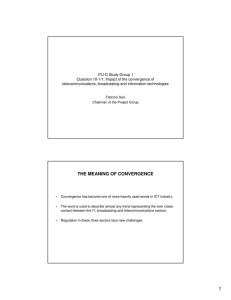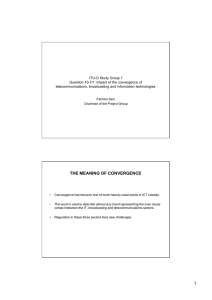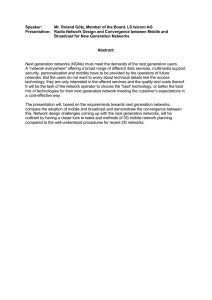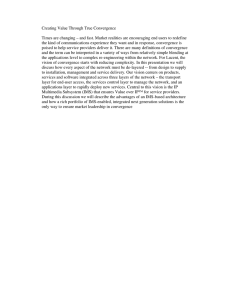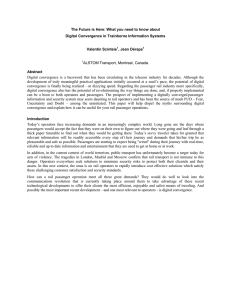1 Promoting convergence to develop ICT markets and realize its benefits... telecommunications regulators in promoting convergence?)
advertisement
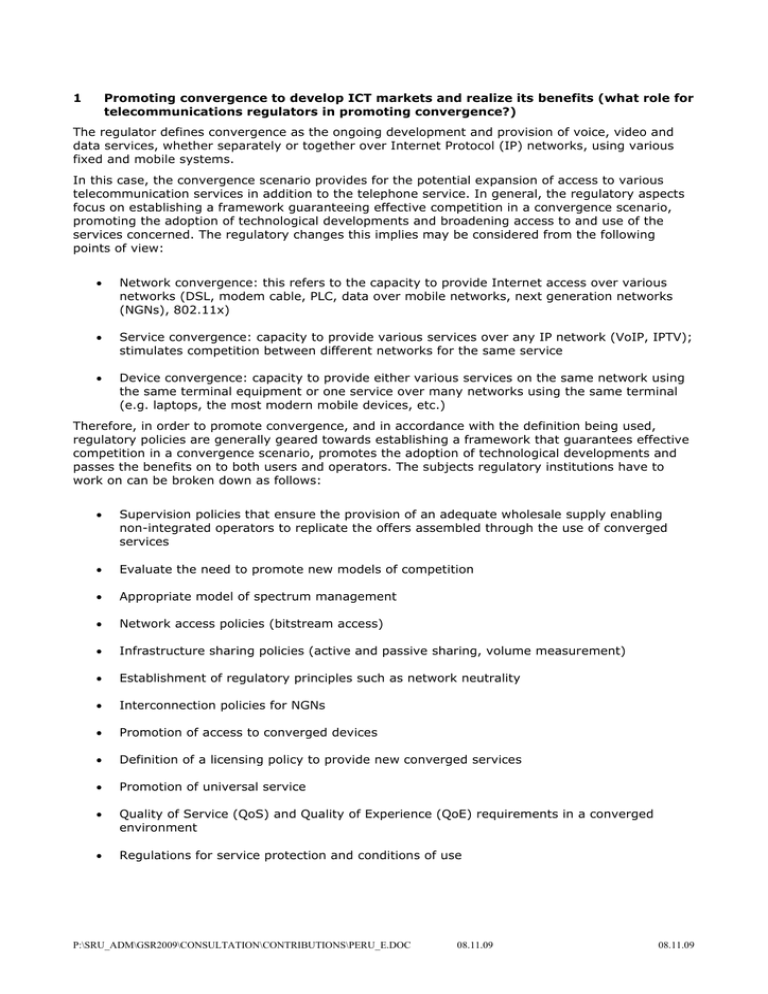
1 Promoting convergence to develop ICT markets and realize its benefits (what role for telecommunications regulators in promoting convergence?) The regulator defines convergence as the ongoing development and provision of voice, video and data services, whether separately or together over Internet Protocol (IP) networks, using various fixed and mobile systems. In this case, the convergence scenario provides for the potential expansion of access to various telecommunication services in addition to the telephone service. In general, the regulatory aspects focus on establishing a framework guaranteeing effective competition in a convergence scenario, promoting the adoption of technological developments and broadening access to and use of the services concerned. The regulatory changes this implies may be considered from the following points of view: • Network convergence: this refers to the capacity to provide Internet access over various networks (DSL, modem cable, PLC, data over mobile networks, next generation networks (NGNs), 802.11x) • Service convergence: capacity to provide various services over any IP network (VoIP, IPTV); stimulates competition between different networks for the same service • Device convergence: capacity to provide either various services on the same network using the same terminal equipment or one service over many networks using the same terminal (e.g. laptops, the most modern mobile devices, etc.) Therefore, in order to promote convergence, and in accordance with the definition being used, regulatory policies are generally geared towards establishing a framework that guarantees effective competition in a convergence scenario, promotes the adoption of technological developments and passes the benefits on to both users and operators. The subjects regulatory institutions have to work on can be broken down as follows: • Supervision policies that ensure the provision of an adequate wholesale supply enabling non-integrated operators to replicate the offers assembled through the use of converged services • Evaluate the need to promote new models of competition • Appropriate model of spectrum management • Network access policies (bitstream access) • Infrastructure sharing policies (active and passive sharing, volume measurement) • Establishment of regulatory principles such as network neutrality • Interconnection policies for NGNs • Promotion of access to converged devices • Definition of a licensing policy to provide new converged services • Promotion of universal service • Quality of Service (QoS) and Quality of Experience (QoE) requirements in a converged environment • Regulations for service protection and conditions of use P:\SRU_ADM\GSR2009\CONSULTATION\CONTRIBUTIONS\PERU_E.DOC 08.11.09 08.11.09 -2- 2 Building effective regulatory institutions (converged regulator or cooperation amongst sector-specific regulators?) Generally speaking, the institutions in charge of defining policies for the sector will have to clearly define their functions in line with the shared objective of promoting access to and use of services in a competitive framework, so as to preclude implementation conflicts in the new convergence scenario. In addition, the regulator must be independent and have the necessary legal instruments to promote competition and implement effective measures for heightening sector efficiency. In this respect, in a convergence scenario it is important for institutions to incorporate the focuses needed adequately to define policies. They must above all analyse the impact of the telecommunication market on the competition model and on the use of and access to the various services, for example in areas such as spectrum management or respect for the principles of technological neutrality (especially between fixed and mobile operators) and neutrality on the services provided (voice, data and broadcasting services should be allowed) when awarding licences. 3 Using regulatory tools to stimulate investment in a converged world Osiptel’s policy on stimulating investment in converged technologies can be summed up in the following points: 9 Where economically feasible, give priority to a model of infrastructure-based competition in which various independent networks compete with each other. 9 Policies for sharing infrastructure: foster the creation of independent bodies that facilitate the shared use of mobile networks, which would allow for enhanced deployment of those networks and also avoid inefficient network duplication. 9 Policies for NGN interconnection: in order to ensure an adequate wholesale supply enabling non-integrated operators to provide converged services, it is considered necessary to promote a regulatory framework that facilitates the establishment of IP interconnections; conduct public consultations to discuss the policy of interconnection charges in an environment of NGN networks; gauge the need to expand the number of interconnection points on the network. 9 Access policies: maintain and improve implementation of policies for bitstream access; access tariffs should be assessed in the light of cost orientation and reasonable earnings, so as not to discourage the future deployment of networks by the major operators. 9 Promote the efficient and competitive rental of circuits when said circuits are provided by a major operator, in order to reduce network deployment costs by the other operators. 9 Free competition: guarantee free competition, avoiding, for example, exclusivity agreements with end users for network access. 9 Ease the conditions for investment projects: promote projects to invest in fibre networks in currently unserved areas, whether from the public purse or by public-private associations. 9 Adapt existing regulations to a convergence context: ensure that some categories of appropriate licences are available to VoIP service providers (non-network-based); facilitate the entry of new operators into the market by generating incentives for lower prices; implement regulations for the development of networks in municipalities. P:\SRU_ADM\GSR2009\CONSULTATION\CONTRIBUTIONS\PERU_E.DOC 08.11.09 08.11.09 -3- 4 Stimulating growth in innovative applications and devices towards connecting the unconnected To stimulate greater use of converged applications, it would be wise adequately to regulate the protection and conditions of use of converged services. This would facilitate competition between traditional and converged services, ensuring certain standards of quality for the final advanced services. Specifically, with regard to VoIP services, we recommend the removal of any obstacle to the emergence of a reference model for the implementation of VoIP in Peru (improved rules, administrative procedures, etc.). Lastly, the reduction or elimination of tariffs for mobile terminals (which has already been done in the case of Peru) and converged devices (Netbooks and personal computers, etc.) and subsidies for VoIP adapters can be useful policies for encouraging access to converged devices. P:\SRU_ADM\GSR2009\CONSULTATION\CONTRIBUTIONS\PERU_E.DOC 08.11.09 08.11.09

